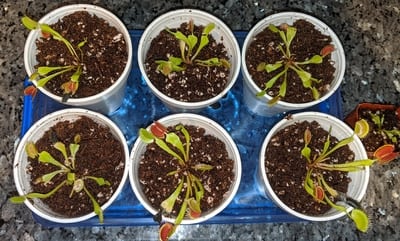Growing a Venus flytrap indoors is a challenging but rewarding experience. This article will guide you through all the indoor care considerations you need to master to keep your plant alive and thriving.
Venus flytraps can grow in indoor environments as long as they have access to over 6 hours of light (sunlight or artificial), high amounts of pure water, and insects for consumption. The plant should be potted in carnivorous plant soil without fertilizers or added nutrients.
The following list includes a summary of the care considerations for growing Venus flytraps.
- Light: Expose the plant to at least 6 hours of light a day. Optimally, they should receive 12 hours of light. The light source can be sunlight or artificial lighting for indoor locations.
- Soil: Do not employ standard potting soil. Instead, make or buy nutrient-free carnivorous plant soil. Only utilize nutrient-free ground for Venus flytraps.
- Watering: Only water with pure water sources, such as rainwater, distilled water, or reverse osmosis water. Water frequently to keep the soil humid at all times but do not flood it.
- Feeding: Venus flytraps do not need bugs to survive, but access to feed promotes their growth.
- Dormancy: Venus flytraps must undergo dormancy every year. They need to be exposed to temperatures below 45 F to achieve the dormancy state.
- Unwanted Stress: Avoid exerting stress on your plant. Do not trigger the traps with your fingers. Also, place the plant in a tranquil location without too much contact with humans.
- Pot Characteristics: The best pots for Venus flytraps are tall, provide good insulation, and they do not leach any components to the ground.
- Trimming: Black leaves are not harmful to the plant, but you can remove them by cutting them from the base.
- Fertilizers: Do not fertilize Venus flytraps.
- Temperature: Venus flytraps are resilient plants. They can withstand temperatures between 32 F and 95 F.
- Humidity: A humid environment is optimal for Venus flytraps. Still, these plants can adapt to dry climates.
- Flowers: Venus flytraps produce flowers during the spring. You can let your plant flower or prevent it from flowering and promote the plant’s growth.
- Terrariums: It is a challenge to grow Venus flytraps in a terrarium as enclosed structures tend to be restrictive. However, it is possible as long as you ensure proper drainage and access to suitable lighting.
After you have reviewed the list above, make sure to download the printable care instructions for growing Venus flytraps indoors. Also, check the next sections. They explain in detail how to build a proper indoor setup for your Venus flytrap.
Growing Venus fly traps indoors is often a challenge. If you are worried your plant might be struggling, check out this article on common causes for black leaves and how to prevent them.
Follow this link to download the complete indoor Venus flytrap care sheet
Provide over 6 hours of direct lighting
Venus flytraps require plenty of lighting to be healthy. In an indoor setting, you have three options: find a sunny window, employ artificial lighting, or do both. The objective overall is to expose your plant to at least 6 hours of light a day (and optimally 12). Now, let’s explore each option:
Sunny window: Find a bright window or screen door that provides several hours of direct/indirect sunlight. South-facing windows are usually the brightest, but it depends on your location. Also, monitor the temperature in the window sill before you place your plant. Sometimes windows can act as a magnifying glass and dangerously heat up your plant.
Artificial lighting: Thanks to artificial lighting, you can grow Venus flytraps in almost any home (even basements with no windows). Do not employ standard light bulbs; they produce too much heat and can burn your plant. Instead, employ a plant light to fulfill your plant’s lighting requirements. You have two options:
- High output fluorescent lights
- LED plant lights
Both are inexpensive and practical options. When choosing a fluorescent light, pick cool colors that promote growth. For LED lights, choose 40-50 Watt LED lights. I have used this small LEDplant light (which costs less than $30) to grow some of my Venus flytraps, and they are thriving.
Also, make sure to buy a plant light that has an automatic timer functionality. The timer will turn the lamp on automatically for 3, 6, or 12 hours daily. I always set them to 12 hours to make sure the plants get enough light. The automatic timer functionality is a lifesaver when you go on vacation and can’t be turning on and off the lamp every day.
These are the grow lights I use to grow Venus flytraps. sundews, and pitcher plants indoors:
- Small plant light for 1-4 plants: https://amzn.to/2RsGlxr
- T8 LED light fixture for multiple plants (6500k Cool White): https://amzn.to/3uWoeh2
Sunny window and artificial lighting: Are you unsure the lighting is enough? You can employ a combination method and use artificial lighting while placing your Venus flytrap in a sunny window. However, I do recommend to do it by parts. Start by first introducing your plant to the window sill. Then, after a week, add artificial lighting. Start with only a few hours of artificial lighting and increase as you see necessary.
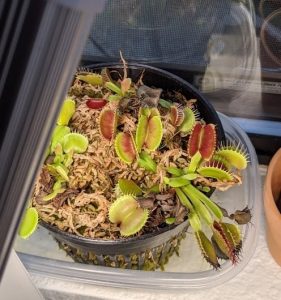
How to know if the lighting is enough?
Your plant will indicate if it is receiving enough light. Venus flytraps usually exhibit lime green and bright red coloring. However, when the plant does not receive enough light, the red pigment inside the lobes is lost. Red colors inside the traps are an indication of appropriate light exposure.
Disclaimer: not all varieties of Venus flytrap exhibit the same coloring scheme. Some characterize with intense red coloring in the lobes; others do not develop any color besides green.
Employ carnivorous plant soil
Venus flytrap and carnivorous plants, in general, require a particular potting medium to survive: Nutrient-free, mineral-free soil. Standard potting soil from familiar brands such as Miracle Grow can kill Venus flytraps. Those potting soil are loaded with minerals and fertilizers that kill Venus flytraps.
Employ a combination of these components to make suitable carnivorous plant soil: long-fibered sphagnum moss, peat moss, silica sand, and perlite. Some common combinations are one type of moss and silica sand or perlite. Or, both kinds of moss and silica sand or perlite. Here are a few commonly used recipes:
- 3 parts peat moss and 1 part perlite
- 2 parts peat moss, 2 parts sphagnum moss, and 1 part sand
When planted indoors, Venus flytraps are not exposed to high temperatures. Therefore, you must ensure the plant is set in soil with good drainage that prevents rotting. Always employ soil that contains at least one draining agent: perlite or silica sand. These components break up the ground, provide aeration and drainage.
Where to Get the Soil
You can buy some of the ingredients above and make your own carnivorous plant soil. When you buy the ingredients, make sure the components are pure. They shouldn’t have any minerals or fertilizers.
Also, you can buy ready-made carnivorous plant soil. Amazon and Etsy are great places to find good quality soil in a small or medium-size quantity. Just search for carnivorous plant soil, and you will find many options.
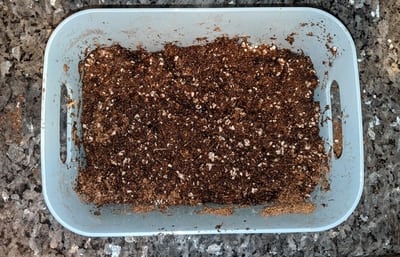
Water frequently with distilled water or rainwater
First, never employ tap water or bottled water for your Venus flytrap. Always utilize pure water sources, such as:
- Distilled water
- Reverse osmosis water
- Rainwater
Stick to the water in the list and your plant will be healthy.
Venus flytraps prefer humid soil mediums. Water your Venus flytrap often to keep the ground moist at all times (in this guide I can teach you exactly how much water do you need for Venus flytraps) (in this guide I can teach you exactly how much water do you need for Venus flytraps). Once it is almost dry, water it again. Never let the soil go completely dry.
The water consumption of Venus flytraps varies through the seasons. However, when placed indoors, the variations will be minimal since the temperatures remain stable.
Indoors, Venus flytraps have higher risks of developing root rot due to overwatering. Luckily is is possible to save a Venus flytrap with root rot (here is how you solve it). You must be careful watering your plant. After you poured the water, use your fingers to touch the ground. The ground should be humid, yet not damped or flooded. Venus flytraps do not grow in swamps; also, they are not aquatic plants. But, they do like moist mediums with high humidity.
Feed your Venus flytrap once a month
Venus flytraps, just like other carnivorous plants, capture insects with their trapping mechanisms. Then, they digest those insects and absorb key nutrients. Those nutrients they extract from prey are not required for the plant’s survival; they are only a boost to their diet. At the end of the days, Venus flytraps produce its own food through photosynthesis.
Venus flytraps benefit from consuming an occasional bug. Outdoor Venus flytraps can capture their own food. Indoors, it is a major challenge.
When you grow Venus flytraps indoors, you will have to take care of the feeding for the most part (sometimes indoor plants do capture a lost bug). This section will teach you the basics of how to feed your plant.
Food options: Feed your Venus flytrap with insects or arachnids only. Do not experiment with human food. The plant won’t be able to process it. You can buy live insects or buy dried up ones, like the ones in the pictures below:
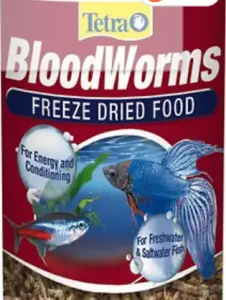
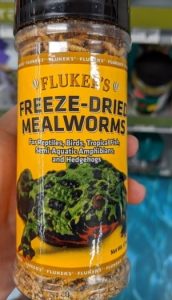
You can buy the freeze-dried insects in almost any pet store. They are common food supplies for reptiles and fish. Before you feed this food to a Venus flytrap, you must rehydrate the worm, just add a few droplets of water.
Feeding basics:
- Choose an insect that is small enough to fit inside the trap of your Venus flytrap
- You only need to feed one trap in the whole plant
- Allow for 2-6 weeks between feedings
- Do not feed a Venus flytrap during dormancy
- Avoid feeding the plant when it is sick or adjusting to a new environment.
Feeding instructions:
- Prepare the bug: If the bug is alive, make sure you have it under control. And dried-freeze bugs need to be dehydrated.
- Insert the bug inside the trap: Place the prey in the center of the trap and attempt to stimulate the trigger hairs inside the lobes.
- Let the trap close: After the trigger hairs are stimulated, the lobes will close.
- Continue to stimulate (dead bugs): When you use a dead bug, the trap must be stimulated to trick the plant into believing it caught live prey. Use your fingers or a small tool like tweezers or chopsticks and press the sides of the trap together. Repeat the action for a minute and then stop.
Feeding a Venus flytrap is not particularly hard, but it is all about mastering the technique. Improper feeding can kill the plant’s leaves. If you would like to get all the details about Venus flytrap food options and complete feeding instructions, check this resource:
Ensure your Venus flytraps go dormant once a year
Venus flytraps require a period of dormancy every year. During dormancy, the plant hibernates or rest for 2-3 months during the winter.
While dormant, Venus flytraps do not look its best. They tend to shrink in size; they lose a bunch of leaves and focus on growing its roots rather than leaves. Even though it might not sound appealing to make your plant dormant, it is a necessary process. When a Venus flytrap skips several dormancies, the plant dies.
Indoors, it is impossible to make your Venus flytrap go dormant. Venus flytraps need to be exposed to temperatures below 45 F (7 C) to achieve dormancy. So, you must place your plant in a cold location to achieve dormancy.
Place your plant in a porch, outside a window, in a cold basement or garage during the winter months. After a few weeks in cold temperatures, you will notice some changes in your plant. Then, let your plant experience the dormancy period. Do not be too worried about the loss of leaves and sluggish look. The plant will look down during its resting period.
Care During Dormancy:
During dormancy, it is best to give Venus flytrap more independence. Follow these instructions to keep your plant healthy through the winter:
- There is no need to feed Venus flytraps during dormancy (find more information about venus flytrap dormancy in this article) (find more information about venus flytrap dormancy in this article)
- Continue watering the plant often, but space out the watering frequency. The plant will consume less water.
- Do not apply fertilizers to the plant.
- Slowly introduce the plant to lower lighting at the beginning of winter. Then, slowly reintroduce the plant to light when exiting dormancy.
- Avoid extreme temperatures below freezing.
Avoid trigerring the leaves and causing stress
The trapping mechanism of the Venus flytrap is quite complex. Also, controlling those traps that open and close takes up large amounts of energy from the plant. When handling a Venus flytrap, you should avoid triggering the traps. The only time when the leaves should close is during feeding. Touching a Venus flytrap and playing with its traps won’t kill the plant, but it weakens the leaves and eventually causes leaf loss.
Indoors, Venus flytraps are prone to more manual stress. For best results, place the plant in a tranquil area. For example, avoid placing a Venus flytrap in a window sill if it will continuously be in contact with a flowing curtain. Also, consider putting the plant out of reach of small children or pets.
Use tall pots with drainage
Choose the appropriate pot for your Venus flytrap by considering three factors: size, material, and drainage.
Size: Venus flytraps have long roots, and they grow well in tall pots. In terms of diameter, the optimal size for a Venus flytrap depends on the plant’s dimensions. A small Venus flytrap can grow well in a 2-inch pot (diameter). As it grows, transfer the plant to 4 and 6-inch pots.
Materials: The best pot materials for Venus flytrap pots are plastic, glazed ceramic, and Styrofoam. Avoid un-glazed ceramic, clay, and terracotta pot. Those materials leach minerals to the ground that harm Venus flytraps. Glass and metal pots are acceptable materials. However, they do not provide good insulation. Only employ if the plant is not exposed to extreme temperatures.
Drainage: Always employ pots with a drainage hole. It is not only essential to have soil with good drainage and aeration, but also a pot with a drainage hole.
Trim leaves when they turn black
When the leaves in Venus flytraps wither, they turn to a dark black color. New Venus flytrap owners tend to get worried when they see black leaves in their plant. However, most of the leaves wither due to age.
Generally, black leaves are no threat to the plant. They are just dead foliage. Still, you can remove it to improve the aesthetics or to clean up the pot and leave more room for growth.
Trimming or pruning a Venus flytrap is easy. Grab the black leaf and use some small scissors to cut it off as close to the center as possible. Never try pulling the leaves; you can rip off the bulb and kill the plant.
You have two options to trim the plant. First, you can cut a leaf when it is half-withered. Second, wait until it withers completely. It is beneficial to follow the second option. When a leaf starts turning black, it becomes useless to trap bugs, but it still helps in the photosynthesis process. It is better to wait until the leaf has entirely withered.
Avoid all types of fertilizers
Venus flytraps do not need fertilizers. The nutrients in the fertilizer can weaken and ultimately kill the plant. Instead of fertilizing the plant, feed the plant to provide the additional boost.
Keep Venus flytraps within 20 F to 100 F
Venus flytraps can withstand temperatures between 20 F and 95 F. In their natural habitat, they are exposed to hot summers and cold/snowy winters. Indoors, Venus flytraps won’t usually be exposed to extreme temperatures unless placed in an unheated garage or porch. Follow these two instructions:
- Do not place the plant under the scorching heat. Temperatures above 95 F are risky for the plant, as it can dry up completely.
- During the winter, do not let Venus flytrap freeze completely. They can handle the cold, but they shouldn’t freeze solid. The plant might not recover.
Increase the humidity in the environment
Venus flytraps benefit from humid environments. In the wild, Venus flytraps are exposed to humidity levels surpassing 50% almost all year long. Even though Venus flytrap can adapt to dryer climates, they thrive with some humidity.
It is a challenge to provide a humid environment inside an air-conditioned home, as the air conditioning dries up the environment. However, there are a few ways to go around it:
Mist your plant: Do you use a humidifier at home? It can be beneficial for your plant. Also, using a spray bottle and misting the plant sporadically increases the humidity in the area.
Water plate strategy: Place the plant pot on top of a shallow water container, like a plate. Then, add water to the plate (1-2 inches in height). The soil will be kept moist, and the humidity index will increase.
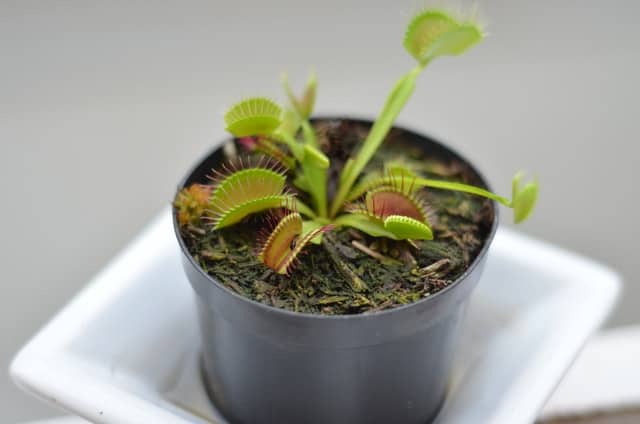
Do not let your Venus flytrap flower
During the spring, Venus flytraps flower. The flowers are not overly unique, but they are pretty to look at. When your Venus flytrap starts flourishing, you have two options:
- Let the plant flower.
- Cut off the flower stalks before they flower.
Why would you choose the second option? Well, Venus flytraps spend a lot of energy producing flowers for reproduction. If you are not interested in collecting seeds, then you can skip the flowering process. Just cut the flower stalks as soon as you spot them, and the plant will have a lot more energy during the growing season.
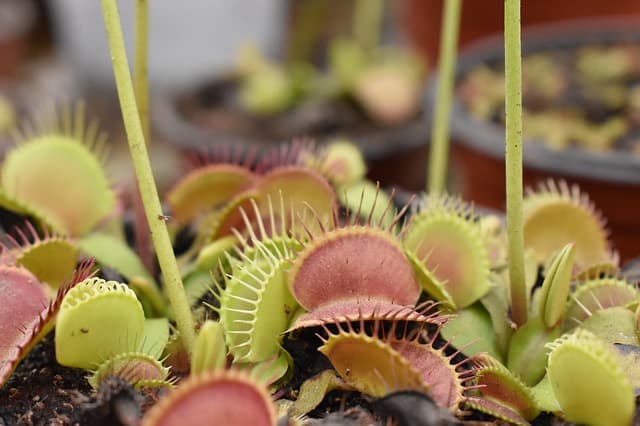
Let the flower stalks flourish if you are interested in collecting seeds and propagating the plant. However, keep in mind that indoors your plant won’t be exposed to pollinators; you will have to pollinate the flowers yourself.
Do not grow Venus flytraps in terrariums
The only place where it is acceptable to grow Venus flytraps in a terrarium is indoors. Terrariums are made of thick plastic or glass. Placing them under direct sunlight can heat up and boil the plants inside.
Growing Venus flytraps inside a close terrarium is a challenging task. Venus flytraps like the humidity inside the terrarium, but other factors are not beneficial. For example, the plant can’t receive enough lighting, it doesn’t have access to feed, and dormancy is impossible inside a terrarium.
Instead of employing an enclosed terrarium, consider using a semi-close terrarium or a greenhouse type terrarium. In greenhouse terrariums, growers place plants in their individual pots within a glass structure (terrarium). Then, it is possible to remove the plant for dormancy and feeding.


